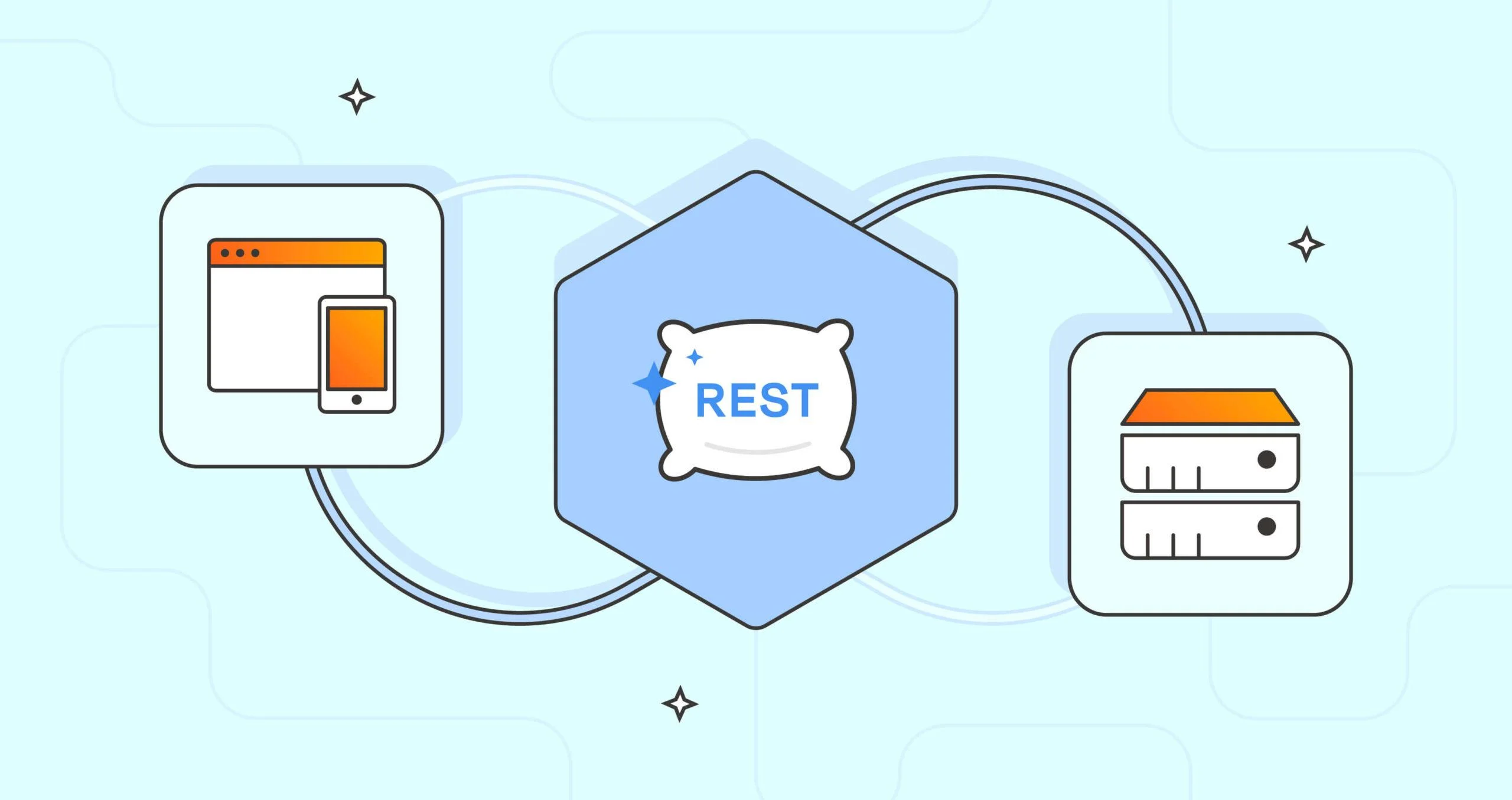📚 Formal Definition of REST API
REST API (Representational State Transfer Application Programming Interface) is an architectural style and set of constraints for designing web services that allow different software applications to communicate with each other over the internet using standard HTTP methods. It enables stateless communication between client and server, where each request contains all necessary information to process it, and responses are structured in a uniform, predictable format.
🔤 Full Form and Breakdown
REST = Representational State Transfer • Representational: Data is represented in a standard format (like JSON) • State: Information about the current condition of resources • Transfer: Moving data between client and server
API = Application Programming Interface • Application: Software programs • Programming: Code-based communication • Interface: A bridge that connects two systems
REST API = A standardized way for applications to request and exchange data over the web using HTTP protocols.
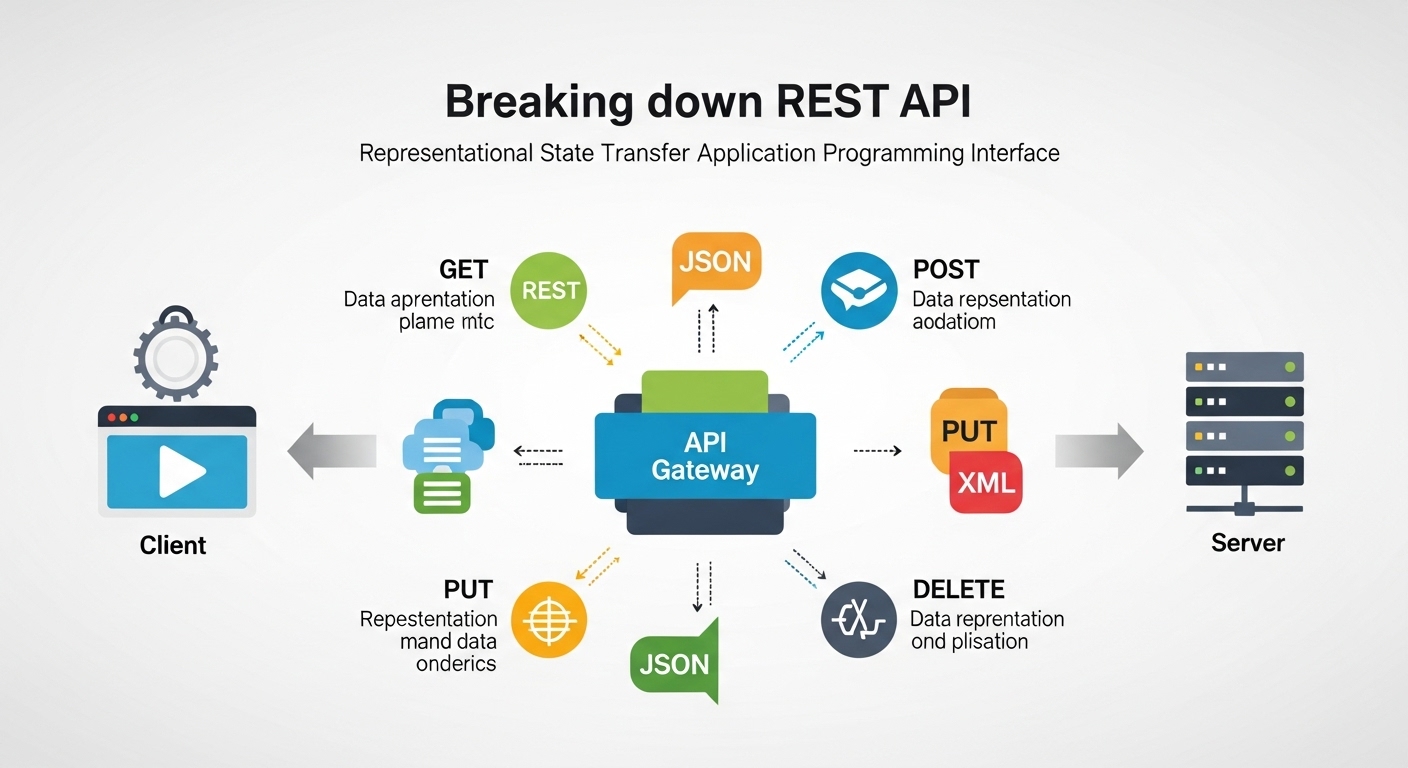
🍽️ Simple Analogy: The Restaurant System
Now let's understand this with a simple analogy. Imagine you're at a restaurant:
- You (Client) - The customer who wants food
- Menu (API Documentation) - Shows what's available
- Waiter (API) - Takes your order and brings food
- Kitchen (Server) - Prepares the food
- Your Order (HTTP Request) - What you ask for
- Your Food (HTTP Response) - What you receive
You don't go into the kitchen yourself - you communicate through the waiter using a standard process! 🍽️
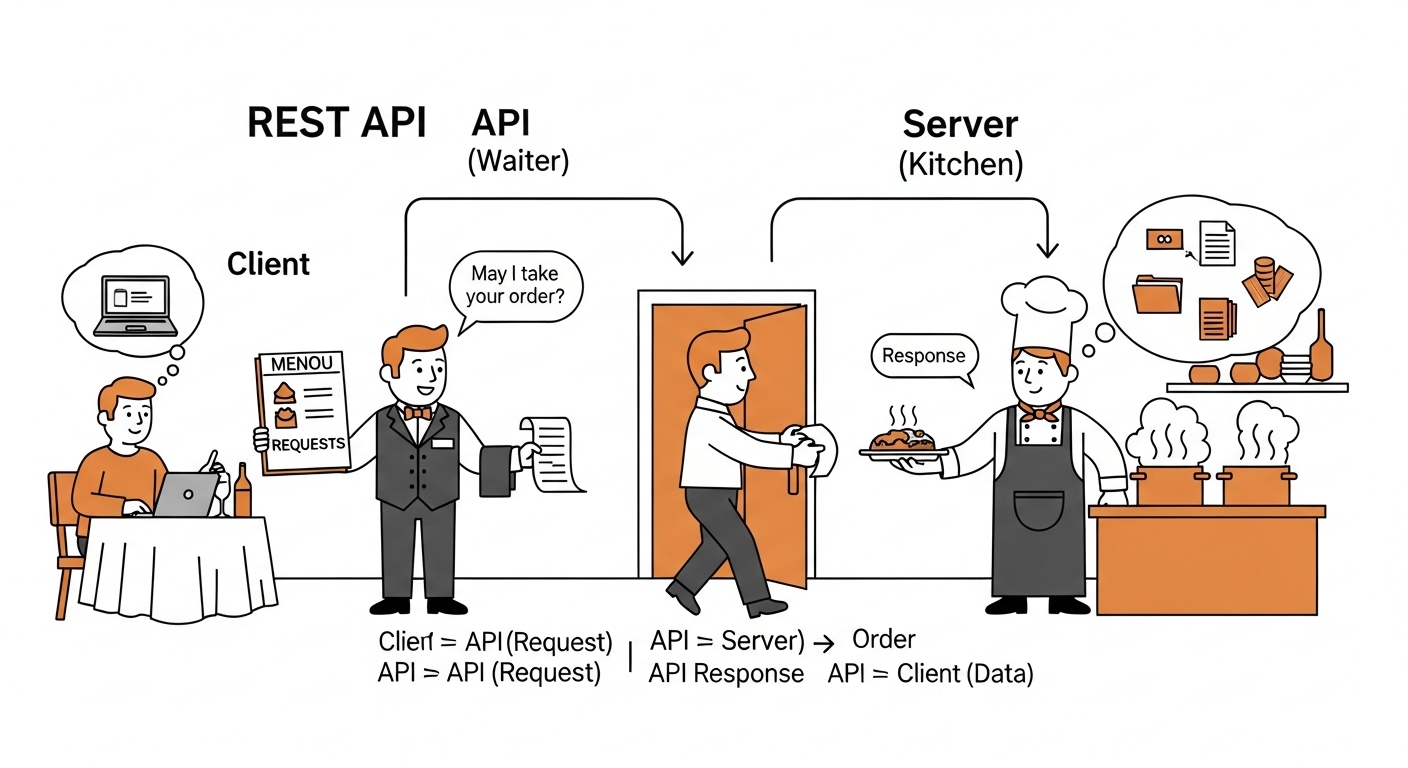
📚 Another Analogy: The Library System
Think of REST API like a public library system:
• You (Client): Want to borrow a book • Librarian (API): Helps you find and get the book • Library Catalog (API Documentation): Shows available books • Library Database (Server): Stores all the books and information • Library Card (API Key): Proves you're authorized to borrow • Library Rules (REST Principles): How you can request and return books
You follow standard procedures to get what you need! 📚
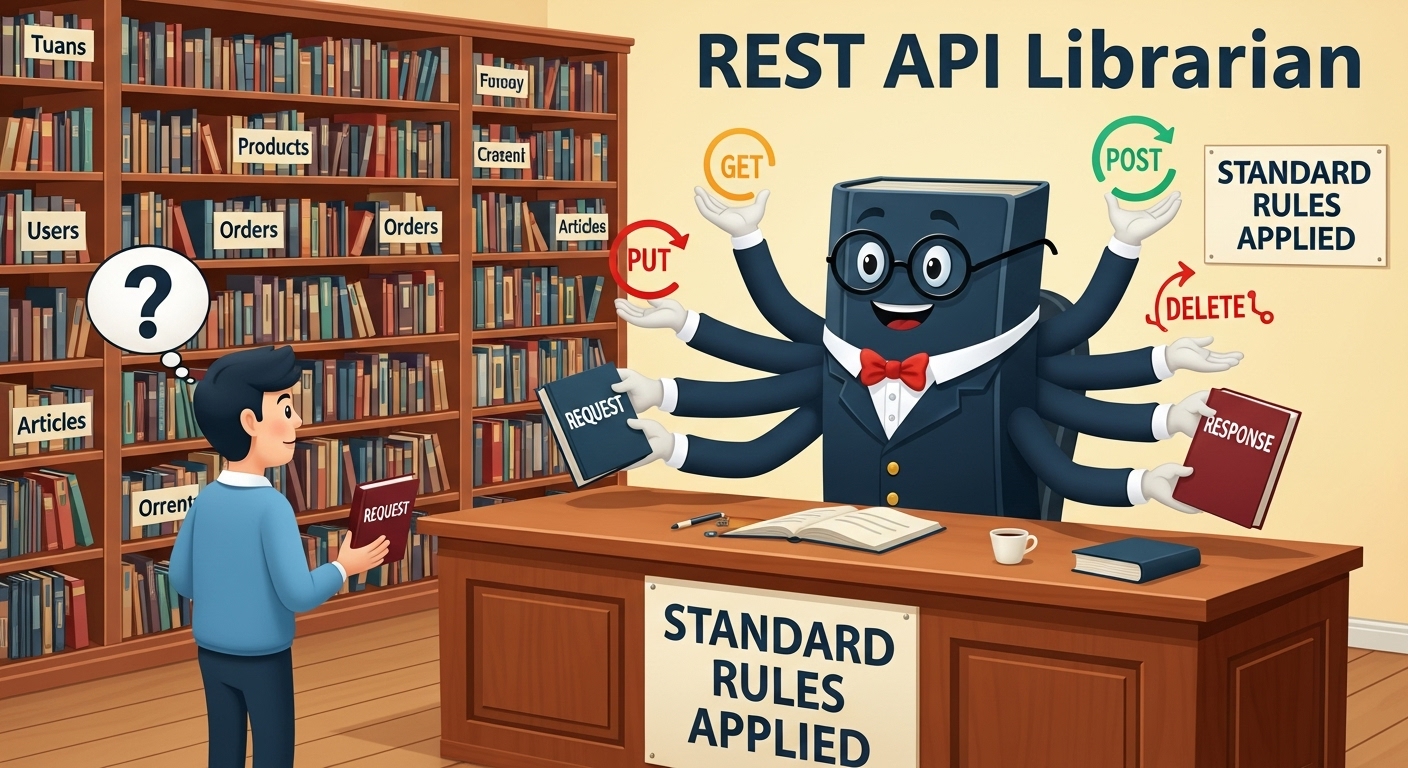
Let's see how REST API works in Instagram (a real example you use daily):
When you open Instagram:
- Your Phone: "Hey Instagram server, show me the latest posts" (GET request)
- Instagram API: Processes your request
- Instagram Server: Retrieves latest posts from database
- Instagram API: Sends back posts in JSON format
- Your Phone: Displays the posts on your screen
This happens in milliseconds! ⚡
Specific API Call Example:
GET https://api.instagram.com/v1/posts/recent
Authorization: Bearer your-access-token
This request asks for recent posts using Instagram's REST API.
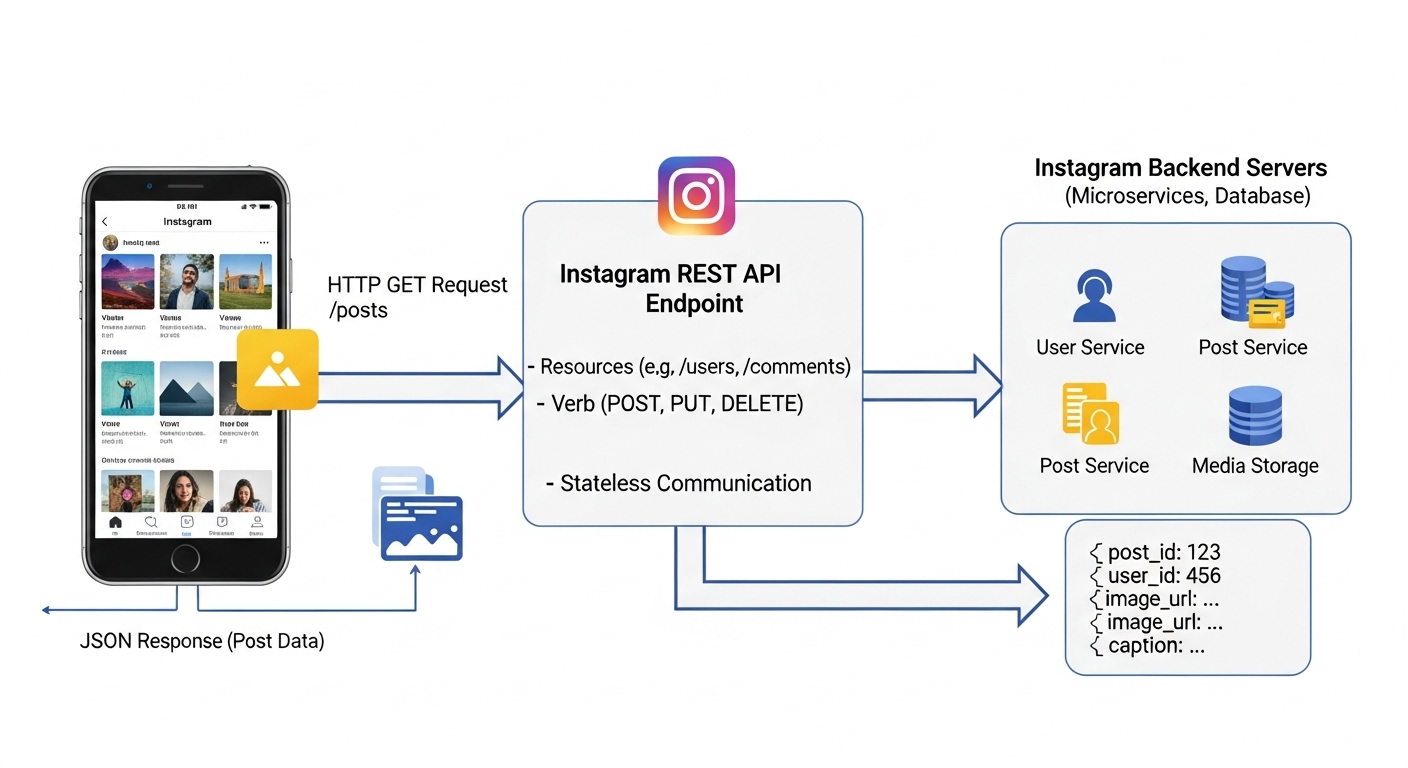
🏗️ The 4 Main REST Operations (CRUD)
REST APIs use 4 main operations, just like basic actions you do every day:
1. GET - Reading/Viewing 👀 • Like asking "Can I see the menu?" • Gets information without changing anything • Example: Getting a list of all books in the library
2. POST - Creating/Adding ➕ • Like saying "I want to order pizza" • Adds new information • Example: Adding a new book to the library
3. PUT - Updating/Changing ✏️ • Like saying "Change my pizza to no cheese" • Updates existing information • Example: Updating a book's information
4. DELETE - Removing 🗑️ • Like saying "Cancel my order" • Removes information • Example: Removing a book from the library

🌐 More Real-World Examples You Use Daily
You interact with REST APIs every day without realizing it! Here are common examples:
Online Shopping (Amazon/eBay): • Browsing products → GET /products • Adding to cart → POST /cart/items • Updating quantity → PUT /cart/items/123 • Removing items → DELETE /cart/items/123 • Checkout process → POST /orders
Weather Apps: • Current weather → GET /weather/current?city=NewYork • 7-day forecast → GET /weather/forecast?city=NewYork&days=7 • Weather alerts → GET /weather/alerts?location=coordinates
Banking Apps: • Check balance → GET /accounts/123/balance • View transactions → GET /accounts/123/transactions • Transfer money → POST /transfers • Update profile → PUT /users/profile
Food Delivery (Uber Eats/DoorDash): • Find restaurants → GET /restaurants?location=zip_code • View menu → GET /restaurants/456/menu • Place order → POST /orders • Track delivery → GET /orders/789/status

📱 How REST API Communication Works
Here's a simple conversation between your phone and a server:
You: Open Instagram app Your Phone: "Hey Instagram server, give me the latest posts" (GET request) Instagram Server: "Here are 20 latest posts" (Response with data) Your Phone: Shows you the posts on your screen
🏷️ REST API URLs (Endpoints)
REST APIs use URLs (web addresses) to know what you want. Think of them like specific addresses:
Examples:
• https://api.instagram.com/posts → Get all posts
• https://api.instagram.com/posts/123 → Get specific post with ID 123
• https://api.weather.com/current/newyork → Get current weather for New York
📊 How JSON is Used in REST APIs
JSON (JavaScript Object Notation) is the primary language that REST APIs use to exchange data. Think of JSON as a universal translator that both computers and humans can easily understand.
Why JSON is Perfect for REST APIs: • Human-readable: You can read and understand it • Lightweight: Small file size, fast transfer • Universal: Works with all programming languages • Structured: Organized like a filing cabinet • Flexible: Can represent complex data relationships
Real JSON Response Example: When you request user information from a social media API, you might get:
1
2
3
4
5
6
7
8
9
10
11
12
13
14
15
16
17
18
19
20
21
22
23
24
25
26
27
28
29
30
31
32
33
34
{
"status": "success",
"data": {
"user": {
"id": 12345,
"username": "john_doe",
"email": "john@example.com",
"profile": {
"name": "John Doe",
"age": 28,
"location": "New York",
"followers": 1250,
"following": 350
},
"recent_posts": [
{
"post_id": 67890,
"content": "Beautiful sunset today!",
"likes": 42,
"comments": 8,
"timestamp": "2025-08-03T14:30:00Z"
},
{
"post_id": 67891,
"content": "Learning REST APIs",
"likes": 25,
"comments": 3,
"timestamp": "2025-08-02T09:15:00Z"
}
]
}
},
"timestamp": "2025-08-03T15:45:00Z"
}How JSON Helps REST APIs: • Standardization: All APIs speak the same JSON language • Easy Parsing: Apps can quickly extract needed information • Nested Data: Can represent complex relationships (user → posts → comments) • Error Handling: Can include status codes and error messages • Flexibility: Can add new fields without breaking existing functionality
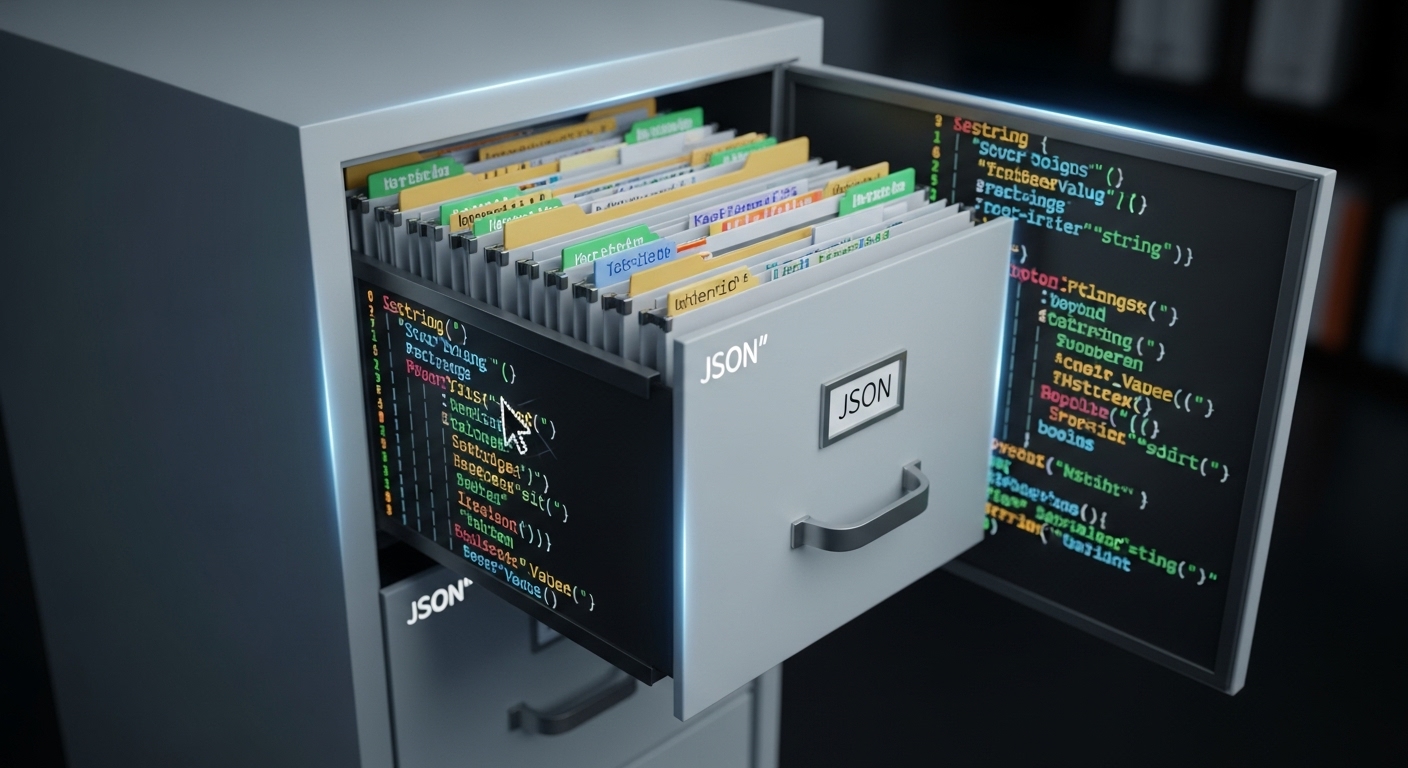
JSON vs Other Formats: • JSON: Like a modern, organized digital notebook • XML: Like an old-fashioned, verbose filing system • Plain Text: Like unorganized sticky notes • Binary: Like secret code only computers understand
JSON strikes the perfect balance - structured yet simple! 📝
🎯 Why Do We Need REST APIs?
1. Separation of Concerns 🏗️ • Frontend (what you see) and Backend (data storage) can work independently • Like having separate teams for restaurant dining area and kitchen
2. Multiple Apps, Same Data 📱💻 • One API can serve web app, mobile app, and desktop app • Like one kitchen serving the dining room, drive-through, and delivery
3. Scalability 📈 • Can handle millions of requests • Like a restaurant that can serve many customers at once
4. Standardization 📏 • Everyone follows the same rules • Like having universal traffic signs that everyone understands
🔒 API Security (The Bouncer Analogy)
Think of API security like a nightclub bouncer:
• API Key: Like an ID card - proves who you are • Authentication: Like checking if you're on the guest list • Rate Limiting: Like "only 5 people can enter at a time" • HTTPS: Like having security cameras - keeps communication safe
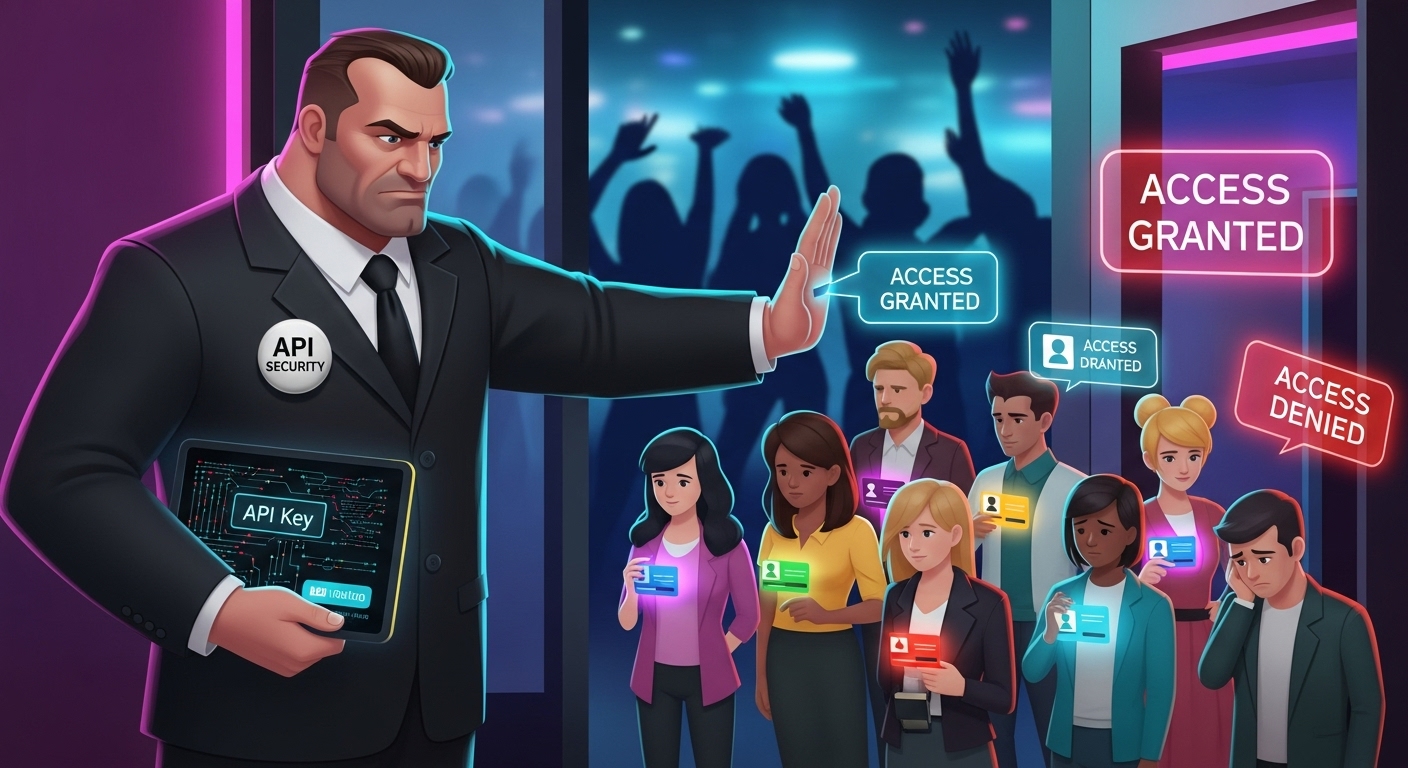
📋 REST API Best Practices (The Good Waiter Rules)
1. Use Clear URLs 🏷️
• Good: /users/123/posts
• Bad: /getUserPostsById?id=123
• Like having clear menu sections instead of confusing descriptions
2. Use HTTP Status Codes 📊 • 200 = "Here's your order!" (Success) • 404 = "Sorry, we don't have that dish" (Not Found) • 500 = "Kitchen is broken" (Server Error) • Like a waiter clearly telling you the status of your order
3. Be Consistent 🎯 • Always use the same naming style • Like a restaurant having the same service style for all customers
💡 Simple REST API Example
Let's say you're building a simple blog. Here's how the REST API would work:
1
2
3
4
5
GET /posts → Get all blog posts
GET /posts/5 → Get blog post with ID 5
POST /posts → Create a new blog post
PUT /posts/5 → Update blog post with ID 5
DELETE /posts/5 → Delete blog post with ID 5🤝 REST vs Other APIs (The Communication Styles)
REST API: Like ordering at a restaurant • You ask, they respond • Simple and straightforward • Most common type
GraphQL: Like a customizable buffet • You specify exactly what you want • More flexible but complex
SOAP: Like formal business correspondence • Very structured and formal • Older, more complex
🚀 Getting Started with REST APIs
As a User: • You're already using them! Every app you use likely uses REST APIs • No need to learn anything special
As a Developer: • Start with public APIs like: • JSONPlaceholder (fake data for testing) • OpenWeatherMap (weather data) • GitHub API (repository data) • Use tools like Postman to test APIs • Learn to make API calls in your favorite programming language

🎓 Key Takeaways
• REST API = A waiter system for computer communication • 4 Main Actions: GET (read), POST (create), PUT (update), DELETE (remove) • You use them daily in every app on your phone • JSON format = Organized data like a digital filing cabinet • Security = Like having a bouncer check IDs • URLs = Specific addresses for different data
🔮 The Future of REST APIs
REST APIs will continue to be important because they're: • Simple to understand and use • Reliable and well-tested • Supported by every programming language • Scalable for large applications
Think of REST APIs as the "universal language" of the internet - they help different applications talk to each other, just like how English helps people from different countries communicate! 🌍
📚 Want to Learn More?
• Practice with free APIs: JSONPlaceholder, Dog API, Cat Facts API • Read documentation: Most APIs have beginner-friendly guides • Try building: A simple weather app or todo list with API integration • Use tools: Postman for testing, curl for command line practice
Remember: Every expert was once a beginner. REST APIs might seem complex at first, but they're just a way for computers to have polite conversations! 🤖💬
